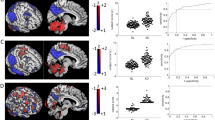Abstract
Single-photon emission tomographic (SPET) images using technetium-99m labelled hexamethylpropylene amine oxime were obtained from 97 patients diagnosed as having Alzheimer's disease, as well as from a comparison group of 64 normal subjects. Multiple linear regression was used to predict subject type (Alzheimer's vs comparison) using scintillation counts from 14 different brain regions as predictors. These results were disappointing: the regression equation accounted for only 33.5% of the variance between subjects. However, the same data were also used to train parallel distributed processing (PDP) networks of different sizes to classify subjects. In general, the PDP networks accounted for substantially more (up to 95%) of the variance in the data, and in many instances were able to distinguish perfectly between the two subjects. These results suggest two conclusions. First, SPET images do provide sufficient information to distinguish patients with Alzheimer's disease from a normal comparison group. Second, to access this diagnostic information, it appears that one must take advantage of the ability of PDP networks to detect higher-order nonlinear relationships among the predictor variables.
Similar content being viewed by others
References
Battistin L, Pizzolato G, Dam M, Ponza I, Borsato N, Zanco PL, Ferlin G. Regional cerebral blood flow study with 99mTchexamethyl-propylenamine oxime single photon emission computed tomography in Alzheimer's and multi-infarct dementia.Eur Neurol 1990; 30: 296–301.
Burns A, Philpot MP, Costa DC, Ell PJ, Levy R. The investigation of Alzheimer's disease with single photon emission tomography.J Neurol Neurosurg Psychiatry 1989; 52: 248–253.
Gemmell HG, Sharp PF, Besson JAO, Ebmeier K, Smith FW. A comparison of Tc-99m-HM-PAO and I-123 IMP cerebral SPET images in Alzheimer's disease and multi-infarct dementia.Eur J Nucl Med 1988; 14: 463–466.
Hunter R, McLuskie R, Wyper D, Patterson J, Christie JE, Brooks DN, McCulloch J, Fink G, Goodwin GM. The pattern of function-related regional cerebral blood flow investigated by single photon emission tomography with 99mTc-HMPAO in patients with presenile Alzheimer's disease and Korsakoff's psychosis.Psychol Med 1989; 19: 847–855.
Jagust WJ, Budinger TF, Reed BR. The diagnosis of dementia with single photon emission computed tomography.Arch Neurol 1987; 44: 258–262.
Neary D, Snowden JS, Shields RA, Burjan AWI, Northen B, Macdermott N, Prescott MC, Testa HJ. Single photon emission tomography using 99mTc-HM-PAO in the investigation of dementia.J Neurol Neurosci Psychiatry 1987; 50: 1101–1109.
Schmitt FA, Shih W, DeKosky SJ. Neuropsychological correlates of single photon emission computed tomography (SPELT) in Alzheimer's disease.Neuropsychology 1992; 6: 159–171.
Smith FW, Besson J, Gemmell H, Sharp P. The use of technetium-99m-HM-PAO in the assessment of patients with dementia and other neuropsychiatric conditions.J Cereb Blood Flow Metab 1988; 8: 5116–5122.
Albert MS, Lafleche G. Neuroimaging in Alzheimer's disease.Psychiatr Clin North Am 1991; 14: 443–459.
Dawson MRW, Schopflocher DP. Modifying the generalized delta rule to train networks of nonmonotonic processors for pattern classification.Connection Sci 1992; 4: 19–31.
Pao Y.Adaptive pattern recognition and neural networs. Reading, Mass. Addison-Wesley.
Ahmad S, Tesauro G. Scaling and generalization in neural networks: a case study. In: Hinton GE, Sejnowski TJ, Touretzky DS (eds)Proceedings 1988 connectionist models summer school. San Mateo Calif. Morgan Kaufmann; 1988.
Shamanski KS, Dawson MRW, Berkeley ISN. The effect of linear separability on learning speed and generalization in monotonic and nonmonotonic PDP networks.Connection Sci 1994; in press.
Frlich L, Eilles C, Ihl R, Maurer K, Lancik M. Stage-dependent reductions of regional cerebral blood flow measured by HMPAO-SPELT in dementia of Alzheimer type.Psychiatry Res 1989; 29: 347–350.
Dobbs A, Heller R, McEwan A.What is the future of staging in dementia? Patient variability. Symposium on Dementia, Canadian Association on Gerontology, Toronto.
Martin A, Brouwers P, Lalonde F, Cox C, Teleska P, Fedio P. Towards a behavioral typology of Alzheimer's patients.J Clin Exp Neuropsychol 1986; 8: 594–610.
McClelland JL, Rumelhart DE, Hinton GE. The appeal of parallel distributed processing. In: Rumelhart DE, McClelland JL and the PDP Research Group (eds)Parallel distributed processing, V.1. Cambridge, Mass.: MIT Press; 1986.
Smolensky P. On the proper treatment of connectionism.Behav Brain Sci 1988; 11: 1–74.
Rumelhart DE, Hinton GE, Williams RJ. Learning representations by back-propagating errors.Nature 1986; 323: 533–536.
Minsky M, Papert S.Perceptrons, 3rd edn. Cambridge, Mass.: MIT Press.
Lippmann RP. An introduction to computing with neural nets.IEEE ASSP Magazine 1987; April: 4-22.
McKhann G, Drachman D, Folstein M, Katzman R, Price D, Statian EM. Clinical diagnosis of Alzheimer's disease: report of the NINCDS-ADRDA work group under the auspices of the Dept. of Health and Human Sources Task Force on Alzheimer's Disease.Neurology 1984; 34: 939–944.
Roth M, Huppert TA, Tym E, Mountjoy CQ.The Cambridge examination for mental disorders of the elderly. Cambridge: Cambridge University Press, 1988.
McEwan AJB, Hooper HR, Kotchon T, McTeer P, Hooper PM. A three dimensional programme to quantitatively analyze cerebral perfusion from HMPAO images: normal and pathophysiological data.Nucl Med Commun 1990; 11: 221.
Hooper HR, McEwan AJ, Lentle BC, Kotchon TL, Hooper PM. Interactive three-dimensional region of interest analysis of HMPAO SPECT brain studies.J Nucl Med 1990; 31: 2046–2051.
Berkeley ISN, Dawson MRW, Medler DA, Schopflocher DP. Density plots of hidden value unit activations reveal interpretable bands and microband. Neural Computation 1994; in press.
Hinton GE, McClelland JL, Rumelhart DE. Distributed representations. In: Rumelhart DE, McClelland JL (eds)Parallel distributed processing, vol. l. Cambridge, Mass: MIT Press; 1986: 77–109.
Baldi P, Chauvin Y. Temporal evolution of generalization during learning in linear networks.Neural Computation 1991; 3: 589–603.
Hertz J, Krogh A, Palmer RG.Introduction to the theory of neural computation. Redwood City, Calif. Addison-Wesley, 1991.
Baum EB, Haussler D. What size net gives valid generalization?Neural Computation 1989; l: 151–160.
Horn D, Ruppin E, Usher M, Herrmann M. Neural network modeling of memory deterioration in Alzheimer's disease.Neural Computation 1993; 5: 736–749.
Author information
Authors and Affiliations
Rights and permissions
About this article
Cite this article
Dawson, M.R.W., Dobbs, A., Hooper, H.R. et al. Artificial neural networks that use single-photon emission tomography to identify patients with probable Alzheimer's disease. Eur J Nucl Med 21, 1303–1311 (1994). https://doi.org/10.1007/BF02426694
Received:
Revised:
Issue Date:
DOI: https://doi.org/10.1007/BF02426694




